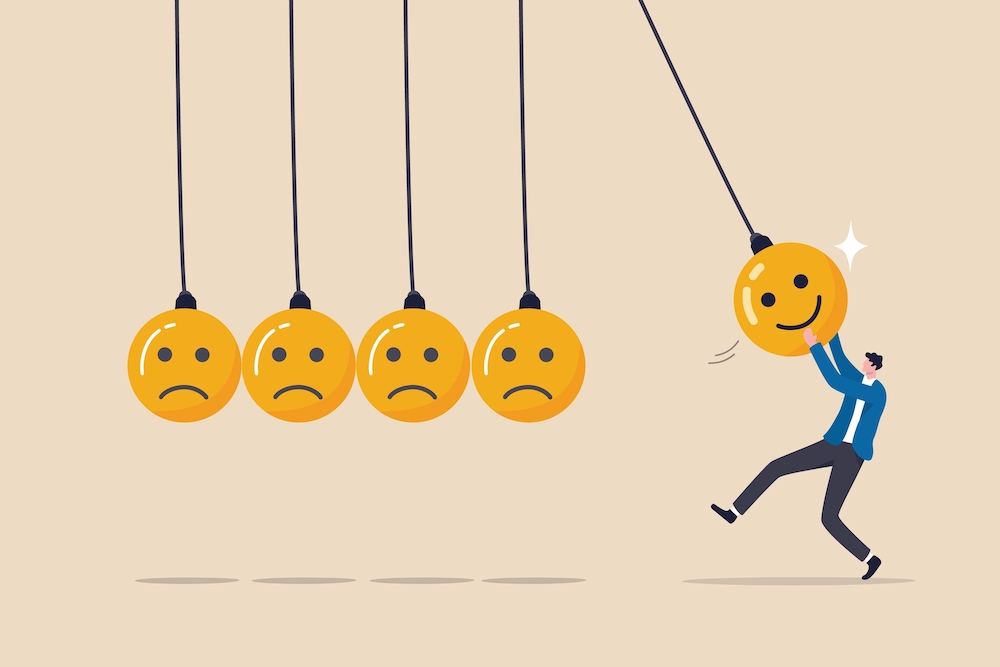In my last few columns, I focused on the ways our emotions can interfere with managing our money and investing well.
Today I want to talk about the positive state that we want to aim for most of the time. This will connect us with the emotional resources and clear thinking we need to make our best financial decisions.
Researchers like Dr. Stephen Porges call it our social engagement system.
When we feel safe, trusting and relaxed, our heart rate and blood pressure lower and our heart rate variability increases.
You see, our heart rate rises a little on the inhale and lowers on the exhale, and the difference between these is our heart rate variability. Higher heart rate variability is a good thing. This is all very beneficial for our immune system, cardiovascular system, organs and overall health.
We’re also more connected with our higher brain functions and the part of our vagus nerve that connects the organs of our body with our brain. This is counter to being in the protect mode of fight or flight, so it lowers our stress levels and makes it easier to think and create with complexity.
When we’re in fight or flight – or the freezing that can happen when we’re in the throes of trauma – we’re not able to distinguish changes in facial expression or vocal tone in others. That means it’s nearly impossible to feel connected and attuned to another person.
It’s best if we can stay out of our fight-or-flight system most of the time, but there are exceptions, of course.
Take Control of Your Nervous System
Athletes tap in to the energy of the fight system without getting lost in rage (most of the time – when athletes “lose it,” they also lose the capacity to think clearly and to connect with teammates and opponents, so they also usually lose the competition).
Like athletes, those of us who work in dangerous professions or live in threatening environments may learn to tap in to this protective system just enough to keep us appropriately vigilant – but not so much that we’re lost in it completely. Learning to ride this edge is part of the training and skill needed to master such circumstances.
When we’re in an emergency situation, we pop into the fight-or-flight part of our nervous system automatically (in as little as one-tenth of a second). This is a good thing… when there’s an actual emergency.
But with our complex brains and histories, many of us can trigger that system – just as automatically and quickly – when there is no actual emergency. This is often the cause of anxiety as well as other psychological symptoms. When that’s the case, it’s even more important to learn how to deliberately move into our social engagement system.
So how do we do that?
One very simple action we can take is to slow and deepen our breathing (not too deep, maybe 20% more) to about four to six breaths per minute. We want to also drop our breath from our chest into our diaphragm so that our belly extends a bit on the inhale. If we can do that for even just two to three minutes, that alone can sometimes calm us, lower anxiety and bring us toward our social engagement system.
Another thing that can help is to notice our physical sensations, bringing our awareness to our skin, any tension in our muscles, our movement, our gut feelings – and noticing the more subtle details of that part of our sensory system.
This is something we’re often not taught to do, but it’s as important as any of the other senses. There are three parts to this.
- Proprioception: awareness of our motion through space and in relation to gravity
- Kinesthesia: awareness of degrees of tension in our muscles
- Visceral sensation: our gut feelings; the perceptions of our internal needs and longings
If you’re not very familiar with these sensations, it can be well worth practicing the above. Imagine your sense of hearing had been muffled for many years and you were suddenly able to hear clearly again. It would take some time and practice tuning in to the different sounds around you to really get comfortable with hearing.
Think of your physical sensations in the same way. Give yourself time to practice tuning in to the physical sensations of your body each day, allowing yourself to settle into more subtle sensations over time.
Our thoughts and emotions can exist anywhere in space or time. We can get lost in memories or imagination, and that can sometimes bring us to troubled places. When we feel anxious, shifting from mental worry or fear into our physical sensations can bring us into the present – and sometimes that alone can dissipate a considerable amount of anxiety.
Another pathway toward spending more time in your social engagement system is to be curious.
A Little Curiosity Goes a Long Way
Curiosity is about exploration and discovery; it creates energy, possibilities and movement. It also allows us to create relationships, have more empathy, and grow more deeply and delightfully connected with one another.
Being curious about someone else’s experience can help us to attune to and connect with another person. The best way to connect to our social engagement system is to deliberately attune to someone we feel safe and good with. If this level of trust and comfort is complicated with the people in your life, you can instead do this with a beloved pet.
Let’s play with this a little. Find a pet if you have one (a cat, dog or horse is great; a fish or snake maybe not so much because they don’t have the capacity of mammals to attune back). If you don’t have a pet handy, see if you can remember a time when you felt a nice, loving connection with a pet.
Whether you’re experiencing it now or remembering it, notice how you feel emotionally as you tune in to that warm connection with the animal. Can you see the animal’s breathing? Notice what you sense in your body – what your breathing is like, your heartbeat, your sense of tension or relaxation.
If you have a cat that you love, can you hear its purr or see its sweet, blinking eyes? If you have a dog that you love, can you see or remember its happy eyes smiling at you, its ears laid back and tail wagging?
As you do this, do you feel anything like a fight-or-flight reaction? Notice any fear or anger? I’d guess that the chances are probably low.
When we know how to connect with a beloved animal like this, it can also help us to better connect with our beloved people too. But in order to do this, we also need to be curious.
Curiosity, therefore, is an excellent ingredient for bringing us away from our more primitive protective reactions and toward more fluid, playful, complex and interesting relations with others.
The more time we can spend in this social engagement system, the broader our thinking and the stronger our sense of emotional resources. It’s also the state that connects us with our higher brain, which is essential for clear thinking and successful decision making.
Of course, this is essential if we want to make the best decisions with our money.
Credit: Source link














